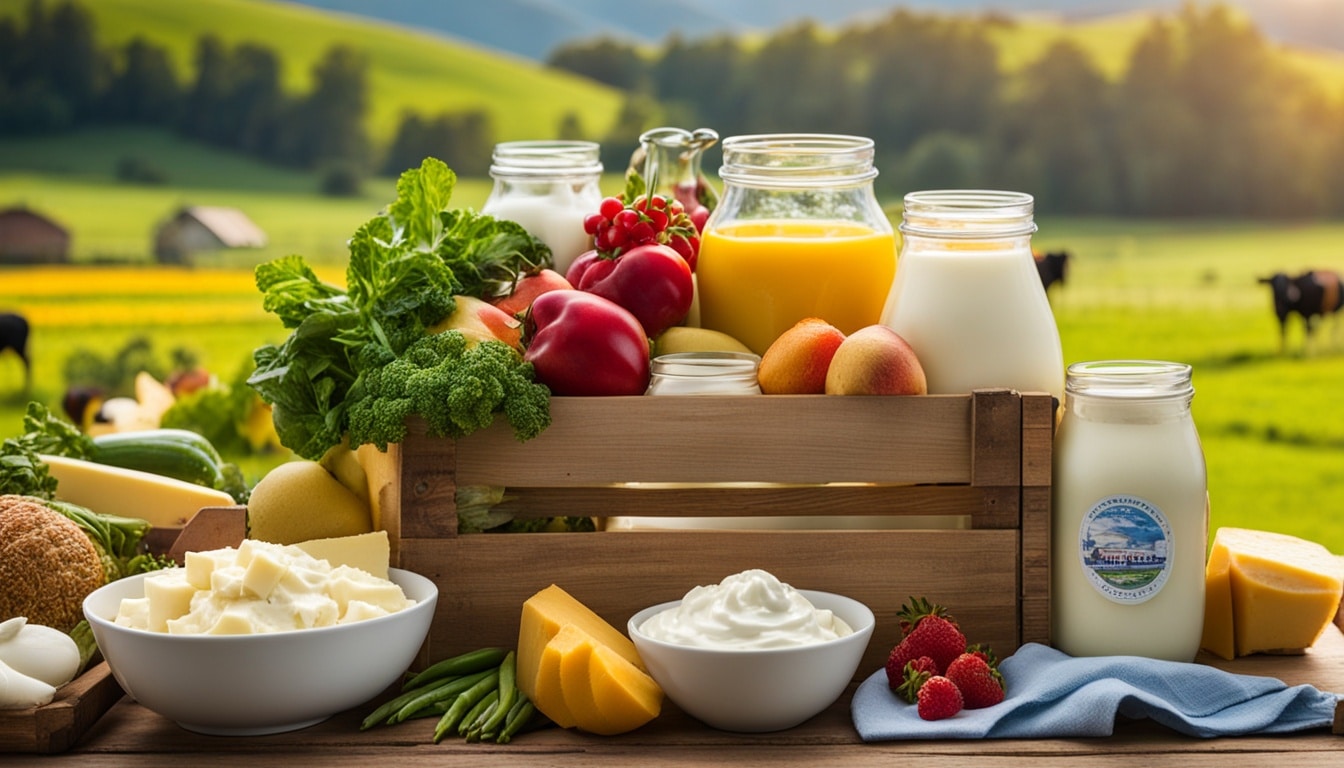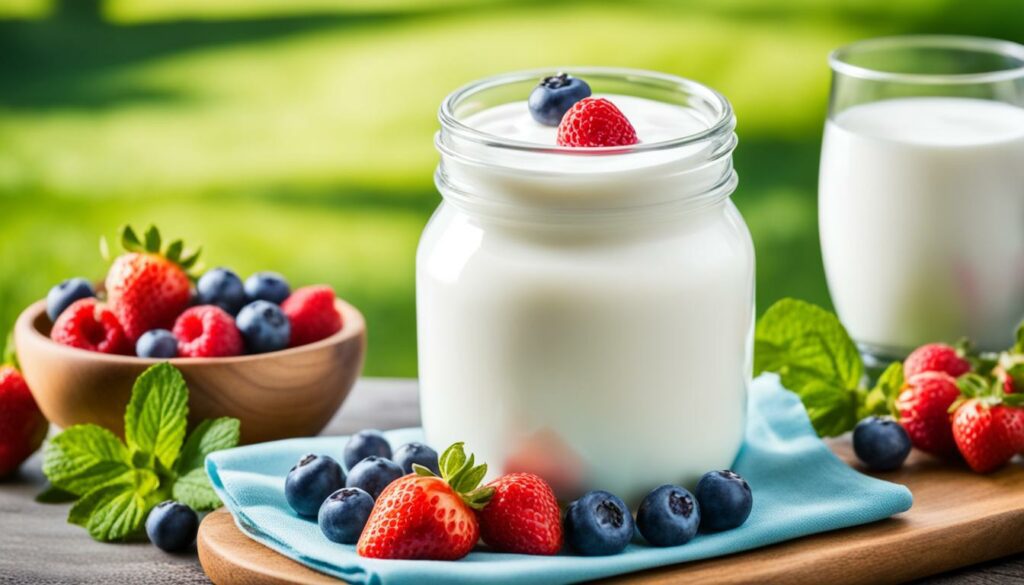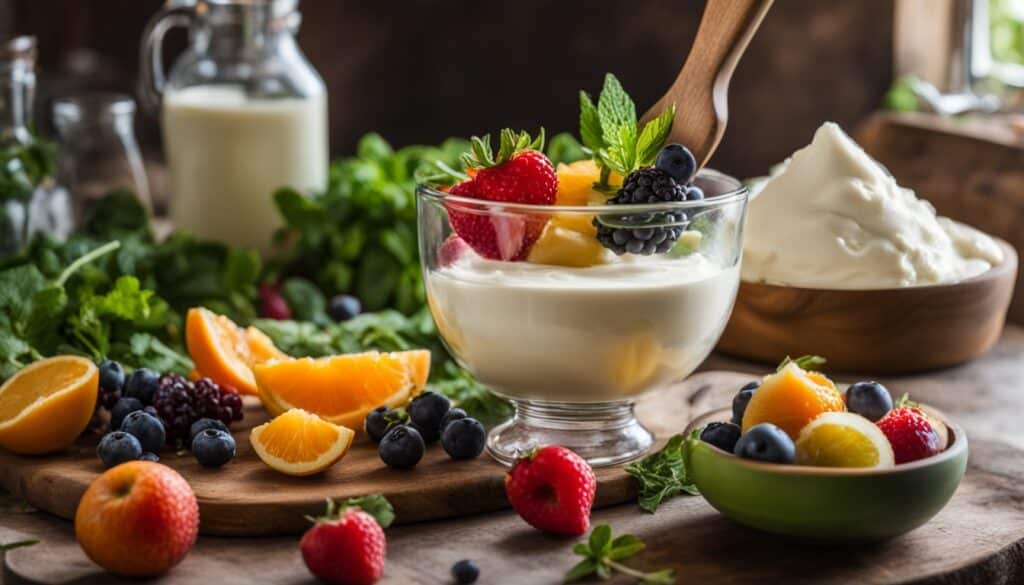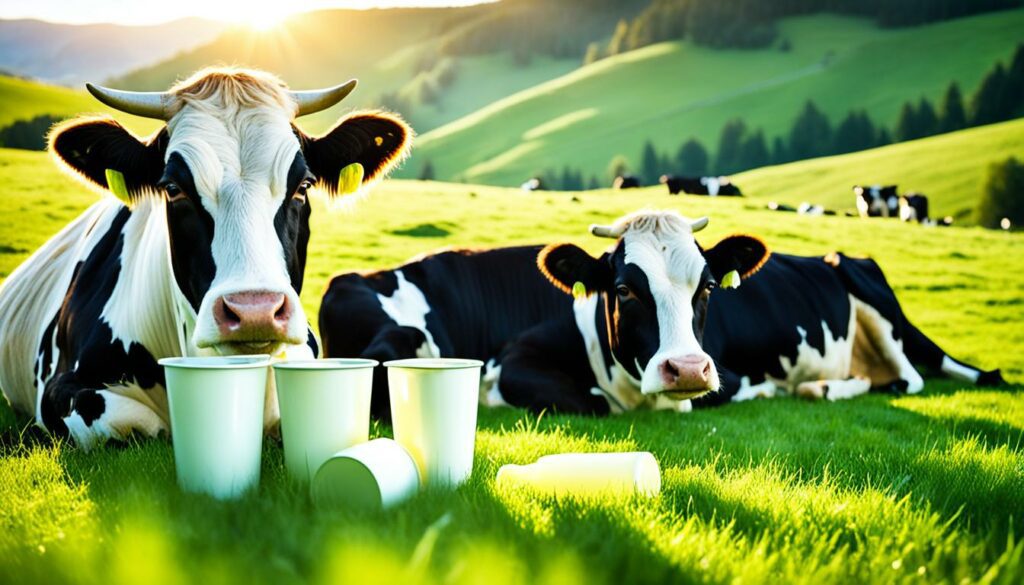Menu

Meet Sally Belle, our star dairy cow. She gives us 2 1/2 gallons of milk a day. What’s special is that her milk has over 30% cream. This creamy milk is perfect for many farm-fresh dairy recipes we enjoy.
Having Sally Belle means we save a lot on milk, which used to cost $10 a gallon. With her milk, we can make delicious things at home. Imagine making creamy yogurt, rich butter, and even ice cream. The options are endless.
This article is all about organic milk culinary uses. We’ll learn to use simple ingredients to make tasty, healthy food. By cooking with pasture-raised dairy, we add more flavour to our meals. Now, let’s explore the joys of making dairy at home.
Farm-fresh dairy offers tasty and healthy recipes. They come from local farms using raw milk and fresh cream. This means each dish is full of real flavour and goodness.
The taste and quality of farm-fresh dairy, like homemade butter, stand out. Making butter from raw milk, you get about half a cup from a half gallon. It takes 10 to 20 minutes to churn it into butter.
Farm-fresh butter has 10-20% less water than many brands. This makes pastries flakier.
“Incorporating ingredients like Triple E Farm’s fresh chicken, eggs, and milk into local dairy farm recipes not only supports local agriculture but also ensures a healthier, more sustainable diet.”
Ingredients like eggs and milk from Triple E Farm are crucial. They are used in recipes for Cheesy Scrambled Eggs and Hearty Soup. Natural cream from raw milk differs by season, showing the farm’s natural cycle.
Here are some wholesome dairy recipe ideas:
Local dairies, like Lutz Farms in North Carolina, provide nutritious milk. A glass of whole milk has 8 grams of protein. Different types of milk contain varying levels of fat.
Eating locally sourced food is crucial. It strengthens the community and teaches children about health and cooking. This promotes a better way of life and the value of farm-fresh dairy.
Making your own ice cream with raw milk and fresh cream is a great experience. You get to use fresh ingredients in a traditional way. This brings a new taste to your desserts.

This ice cream is both tasty and good for you. Each serving has 328 calories, giving you energy. It has a good mix of 18g carbs, 5g protein, and 26g fat. It’s also packed with Vitamin A and Calcium, which are good for your eyes and bones.
| Nutrient | Amount per Serving |
|---|---|
| Calories | 328 |
| Carbohydrates | 18g |
| Protein | 5g |
| Fat | 26g |
| Saturated Fat | 16g |
| Cholesterol | 210mg |
| Sugar | 16g |
| Vitamin A | 1133IU |
| Calcium | 134mg |
| Iron | 0.4mg |
Raw milk adds good bacteria and enzymes to the ice cream. It’s nutritious and easy to digest, especially if you’re sensitive to lactose. So, enjoy making desserts with fresh cream and raw milk. It’s a healthy choice for many people.
Making butter at home is a fun project that anyone can try. It turns cream into a tasty product that adds joy to homemade meals. You’ll need cream that’s really high in fat, preferably 35% or more.
Add a bit of yogurt or buttermilk to the cream to let it culture. Let this sit at room temperature for 12-24 hours. If you’re using special cultures, just a tiny bit is needed. Afterwards, warm the cream in water at around 75°F (24°C) for a few hours.
Cooling the cream quickly makes it ready for churning. This can be done by placing the cream in an ice bath. Then, churn either by shaking it in a jar for several minutes or by using a churner.
You’ll see the cream turn into butter and buttermilk as you continue churning. This usually takes about 45 minutes. Once the butter forms, remove the buttermilk and rinse the butter with cold water. Then, knead it well to remove any excess liquid.
If you like, you can let your cream sit longer to make cultured butter. This gives the butter a slight tang. Many people love its unique, sour taste.
From a half gallon of cream, you’ll get roughly 1/2 cup of butter. Store it in the fridge for a few weeks or freeze to keep it longer. You might also want to add salt or herbs to make flavoured butter.
With these simple steps, you can enjoy the true flavour of homemade butter. It opens the door to creating different tasty dishes with your own butter.
Yogurt is loved in many homes for its health perks and use in dishes. By making it at home with organic milk, you get the freshest probiotic food. Plus, you can try lots of recipes with organic milk.
Two important bacteria make up yogurt: Streptococcus thermophilous and Lactobacillus bulgaricus. It also has other helpful cultures like Lactobacillus acidophilus. These are good for digestion and the stomach. They help with digestion and strengthen the immune system. You can use different kinds of milk to make yogurt. This means it can suit many dietary needs.

To make yogurt, first you heat the milk. This makes it ready for the yogurt culture. You have to cool it down before adding the culture. If you want thick yogurt, put powdered milk in.
Next is the incubation. The yogurt needs to sit undisturbed for 6-8 hours at 110°. You can use a yogurt maker or a dehydrator.
Soymilk yogurt is different. It doesn’t need heating because it lacks the sugar that the culture needs to grow. It only takes 5 minutes of your time, then you wait for about 15 hours. For a thicker yogurt, let it sit for 8-12 hours. You can also strain it to make Greek-style yogurt.
| Yogurt Type | Milk Type | Heating Requirement | Culturing Time |
|---|---|---|---|
| Cow Milk Yogurt | Cow Milk | Yes | 6-8 hours |
| Goat Milk Yogurt | Goat Milk | Yes | 6-8 hours |
| Skim Milk Yogurt | Skim Milk | Yes | 6-8 hours |
| Soymilk Yogurt | Soymilk | No | 6-8 hours |
Using a thermometer helps make sure the milk is the right temperature. Homemade yogurt can be used in many tasty dishes. For kids, you could make frozen yogurt pops or yogurt fruit roll-ups. Making your own yogurt opens up lots of fun cooking ideas.
Making your own kefir boosts your diet with probiotics. It also lets you create tasty, healthy variations. I’ll tell you how kefir fermentation works and how to fit this milk drink into your day.
Kefir smoothies are a wonderful, nutrient-packed drink. They blend its probiotic goodness with great taste. Try these delicious mixes:
Homemade kefir averages at 146 kcals, 11g carbs, with lots of protein and vitamins. Drinking 1/2 to 3 cups a day is great for you. It helps your digestion and boosts your immune system.
There are key steps for successful kefir fermentation. Here are tips to help you:
For cheese recipes, you only need about 1/4 cup of kefir. It adds a great, cultured taste.
| Comparison | Homemade Kefir | Store-bought Kefir |
|---|---|---|
| Number of Strains | 50 | More |
| CFUs | 20 billion | Less |
| Use of Kefir Grains | Yes | No (Lab-raised bacteria) |
These tips help you enjoy making kefir. You’ll get to savor the benefits of this amazing, probiotic drink.
Using farm-fresh dairy in your meals makes them tastier and healthier. Dairy products work well in appetisers, snacks, salads, and desserts. They truly make various dishes come alive.
Let’s look at some numbers to see dairy’s potential:
| Recipe Category | Proportion |
|---|---|
| Desserts | 2/5/24 |
| Salads & Sides | 2/5/24 |
| Appetizers & Snacks | 2/5/24 |
| Breakfast and Brunch | 2/5/24 |
Demand for dairy products is expected to keep growing. By 2022, each person is likely to eat 1.8% more dairy each year. This happens as people choose more nutritious dairy foods and want to back local farms. This way, you enjoy tasty, fresh food and support your local dairy farmers.
Take Sysco for example. They have more than 100 experts in quality assurance, the most in their field. Thanks to them, Wholesome Farms Milk gets to you quickly but stays fresh. It just takes 72 hours from the cow to your fridge.

Sysco’s dairy products meet high standards because of their big quality team. This means every dairy meal you make from local recipes is both tasty and safe to eat.
These dairy meals help you enjoy real farm-to-table cooking. They bring simple, good ingredients together for delicious and healthy food.
Making cheese at home brings joy and lets you make special dairy products for meals. This guide helps you pick the best ingredients and follow each step clearly. You’ll learn to make tasty cheese at home with ease.
You need good quality, fresh milk as the base. Here’s what you’ll use:
| Quantity | Ingredient | Notes |
|---|---|---|
| 1 gallon | Whole Milk | Best with 2% or whole milk |
| 1/2 cup | Heinz Vinegar | Distilled white vinegar |
| 1 tablespoon | Himalayan Salt | Enhances flavour |
Making farmer’s cheese at home is fun and puts you in charge of what’s in it. This easy method is great for enjoying unique dairy treats and sharing them with family. With a rating of 4.7 out of 5 from 12 people, this recipe is both popular and straightforward to use.
I’ve made organic milk recipes a key part of my farm-to-table journey. They bring a burst of nutrition and flavour to our favourite dairy dishes. Each meal is now both wholesome and tasty, thanks to organic milk.

At first, our cow gave us 4 gallons daily. But, when we cut down on grain, this dropped to 2 1/2 gallons. With stable milk production, I started creating many dairy delights for our meals.
From the milk, I churn out about 3/4 pound of cream into butter each day. This butter makes my dishes more delicious. Here’s what my dairy treats offer in terms of nutrition:
| Nutrient | Per Serving |
|---|---|
| Calories | 328kcal |
| Carbohydrates | 18g |
| Protein | 5g |
| Total Fat | 26g |
| Saturated Fat | 16g |
| Polyunsaturated Fat | 2g |
| Monounsaturated Fat | 7g |
| Cholesterol | 210mg |
| Sodium | 41mg |
| Potassium | 186mg |
| Sugar | 16g |
| Vitamin A | 1133IU |
| Vitamin C | 0.4mg |
| Calcium | 134mg |
| Iron | 0.4mg |
We barter milk for piglets and equipment, aiding the farm’s eco-friendliness. It also feeds our meat chickens, laying hens, and our dogs. This way, we make sure no milk is wasted.
These organic milk recipes turn daily dishes into a mix of health and flavour. They truly capture the spirit of farm-to-table cooking.
Farm-fresh dairy jumps baking to a new level, adding flavour and texture. Fresh milk and butter make pastries and cakes something special. They’re tastier and more fun to create and eat, compared to using pre-packaged dairy.
Fresh dairy, especially butter, makes pastries even better. The smell and texture of the butter enhance baking. Sally Belle, my Jersey cow, helps a lot. She gives me plenty of milk for rich, creamy butter. This showcases the goodness of dairy from pasture-raised cows.
A favourite recipe uses the butter I make from Sally’s milk. Here it is:
| Ingredient | Quantity |
|---|---|
| Whole raw milk | 1 1/2 cups |
| Raw cream | 2 cups |
| Egg yolks | 6 large |
| Vanilla | 2 teaspoons |
| Maple syrup or honey | 1/2 cup |
The result is pastries full of flavour and softness. Baking with fresh dairy makes them rich. Don’t they sound lovely?
Using fresh dairy is key in making cakes. It brings moisture and a lot of flavour to the table. Instead of looking to store-bought items, I turn to fresh milk and cream. They come from local farmers and my cow, Sally Belle. This keeps the spirit of community alive in our dairy.”My grandpa often enjoys the milk, and we make sure not a drop goes to waste.
Here’s the nutrient info for one of my dairy-included cakes:
| Nutrient | Amount |
|---|---|
| Calories | 328kcal |
| Carbohydrates | 18g |
| Protein | 5g |
| Fat | 26g |
| Saturated Fat | 16g |
| Polyunsaturated Fat | 2g |
| Monounsaturated Fat | 7g |
| Cholesterol | 210mg |
| Sodium | 41mg |
| Potassium | 186mg |
| Sugar | 16g |
| Vitamin A | 1133IU |
| Vitamin C | 0.4mg |
| Calcium | 134mg |
| Iron | 0.4mg |
My cakes are always a hit. People often want the recipe straightaway. Using our creamy dairy is the secret. It mixes tradition and great taste perfectly.
Fresh cream makes dishes rich and smooth, turning ordinary meals into something extraordinary. It’s perfect for making foods indulgent, from savoury mains to fancy desserts. Cream adds a luxurious feel and a burst of flavour to your cooking.
Making your own raw whipping cream is easy and fun. You need raw heavy cream, a sweetener, and vanilla extract. This cream is great for topping cakes and pies, elevating them to gourmet status. It’s a simple way to make any dessert special.

Cream is key in sauce-making, especially for pasta dishes. It turns simple mac and cheese into a velvety delight. Tomato and alfredo sauces also get their creamy texture from it. Creamy dishes are both comforting and tasty, thanks to this ingredient.
Raw ice cream is a unique yet simple treat. It’s full of good fats and nutrients. To make it, mix raw milk, cream, egg yolks, vanilla, and your sweetener of choice. When frozen, it’s a healthy and delicious dessert. It’s important to chill all ingredients well before making it.
Raw butter can be hard to find due to FDA rules, though. But, you can still enjoy raw cream in other recipes. It’s good for making toppings and filling for pastries, safe for those with sensitive stomachs.
Raw cream has several health benefits. It offers enzymes, Omega-3s, and good bacteria. Adding it to your cooking is not only tasty but also good for you. Use cream to discover new flavours and make your meals better.
Seasonal dairy produce brings peak flavours to our food. Farm-fresh dairy recipes use the freshest ingredients. They make our meals full of life. Local milk is rich in essential nutrients, like 8 grams of protein per 8 oz glass. It is great for preparing healthy and tasty dishes.
Now, let’s look at how we can use seasonal dairy produce in our cooking.
Whole milk turns simple meals into creamy, indulgent treats. Try it in dressings that last, like Green Goddess, or Blue Cheese Buttermilk. Keep them in the fridge for freshness.
Experts say we should get 20-35% of our daily calories from healthy fats. Dairy is a good source when used wisely. Different milks have different fat contents, like this:
| Type of Milk | Fat Content per 8 oz |
|---|---|
| Whole Milk | 8 grams |
| Reduced-Fat Milk (2%) | 5 grams |
| Low-Fat Milk (1%) | 2.5 grams |
| Whole Milk Buttermilk | 4.5 grams |
This fantastic resource suggests milk for tasty culinary adventures. It also talks about using fruit purees to add flavour. For example, you can add frozen peach puree to dressings, drinks, or dips. This adds taste and nutrition without extra sugar.
By using wholesome dairy recipe ideas, we get the best of both worlds. We enjoy delicious food and get maximum nutrition from seasonal dairy produce.
Right now, many people care where their food comes from. They look for dairy products that come from farms that care about animal welfare and the environment. By choosing these kinds of products, not only do we help local farmers, but we also get to enjoy better-tasting food.

Making your own lamb milk replacer is a great idea. It saves money compared to buying it in a shop. You can make it using some milk, whipping cream, and an egg for less than what it costs in the store. This way, you save a lot of money and have the ingredients when you need them.
If you make the lamb milk replacer at home, you can change the recipe as the lamb grows. It’s a good way to make sure the lamb grows healthy without getting sick.
Red Barn Family Farms is a great example of a farm that’s doing good for the environment. They make special cheese in a way that takes care of the land and the cows. Their hard work has won them many awards. The farm treats its cows well, and even has their own names.
Trying different types of cheese, like Heritage White Cheddar and Monterey Jack, adds variety to our meals. This kind of cheese comes from farms that are good for the planet and the animals. It supports a type of farming that we should all be doing more of.
In big cities like Los Angeles and New York, there are farms doing things the right way. They work in a way that helps the environment and makes good food. These farms show that we can create food in a way that doesn’t harm the planet.
| Product | Cost (Store-bought) | Cost (Homemade) | Savings |
|---|---|---|---|
| Lamb Milk Replacer | $4.65 – $6 per gallon | $3.90 per gallon | Potentially 50% or more |
| Milk Replacer for 5 Weeks | $30 – $60 | Under $30 | Significant Savings |
In conclusion, using dairy products from farms that look after animals and nature is good for us all. It tastes better, helps the environment, and supports local farmers. It’s a win-win situation which we all should think about.
Keeping farm-fresh dairy fresh for a long time is key. By using different storage methods, the dairy lasts longer without losing quality.
Using the fridge is great for milk and cheese. It keeps them fresh and tasty. Hard cheeses also do well in the fridge, staying good for longer.
Freezing is good for items like butter. But, milk might get grainy if kept too long in the freezer. Soft cheeses don’t last as well frozen, so eat them quickly.
Dehydrating dairy makes it last longer. Freeze-drying keeps most of the nutrients, making powdered milk an easy, long-lasting option.
Practising making hard cheese at home pays off. The more you make, the better it gets. Making more at once saves time and gives bigger rewards.
Having the right tools is crucial for saving dairy. Tools like a Dutch Style Cheese Press make sure the cheese turns out well every time.
| Preservation Method | Best For | Benefits |
|---|---|---|
| Refrigeration | Milk, Hard Cheese | Maintains freshness and flavour, extends usability |
| Freezing | Butter, Various Dairy Products | Effective long-term storage, preserves quality |
| Freeze-Drying | Milk, Eggs | Retains nutrients, enhances shelf-life up to 20 years |
| Dehydration | Meat, Dairy Products | Long-term room temperature storage, maintains shape and flavour |
Taking good care of homemade dairy is essential. It ensures we have fresh dairy even when production slows. It’s both practical and fulfilling to learn these storage skills.
Using farm-fresh dairy daily makes our meals better. It also helps us live healthier. We enjoy special recipes like raw milk ice cream and homemade butter. They taste great and give us good nutrients.
Making our own dairy stuff like yogurt and cheese adds to our meals. We use raw milk, which comes straight from the farm. This way, we eat more natural foods. It helps local farmers and is good for our planet.
Some worry about raw milk. But, knowing how to handle it safely means we don’t have to worry. People in places like Pennsylvania enjoy its benefits. They follow special steps to make sure it’s safe and delicious.
In summary, using farm-fresh dairy in our cooking is rewarding. It brings the joy of fresh, simple tastes. We do our part for the environment and our local area. Exploring farm-fresh dairy shows us a better, more satisfying way to cook.
Farm-fresh dairy is tastier and more nutritious. It supports local farms too. This helps the environment and the farmers.
To make raw milk ice cream, mix raw milk with eggs, honey, or syrup, and vanilla. You can also add cocoa for a chocolate flavour.
Prepare the mix, then chill and freeze it to keep it creamy.
Churn cream until it turns into butter and buttermilk. Butter from cream is rich and tasty. You can use it in many dishes to make them better.
Making yogurt at home is easy and good for your gut. All you need is fresh milk and a way to culture it. You can add it to lots of different meals.
Kefir is a drink with lots of probiotics and health benefits. Making it at home is simple.
You ferment milk with kefir grains. This makes a drink perfect for smoothies or on its own.
Use farm-fresh dairy in meals from morning to night.
Organic milk, fresh cream, and cheese can make your food tastier and healthier.
Making cheese at home is easy. You need fresh milk, rennet, cultures, and some tools. Follow a guide to make your own cheese.
Butter and cream from the farm make baked goods better. They add a richer flavour and texture. This beats using store-bought options.
Fresh cream makes dishes tastier. Use it for sauces, soups, and desserts.
It’s good for sweet and savoury recipes, making food more enjoyable.
Use seasonal dairy for the best tastes and nutrients. Cook various dishes to enjoy fresh, delicious meals.
Choose dairy from local, ethical farms. Look for pasture-raised and grass-fed products. This supports farms and makes your food better.
To keep farm-fresh dairy good, freeze or refrigerate it well. You can also dehydrate it. This makes it last longer and still taste great.